Bonding rubber to metal products and parts that have the advantages of both metal and rubber. Rubber to metal bonded parts are widely applied in applications in a wide variety of industries with its good performance of vibration dampening, shock absorbance, sealing, friction dissipation, noise isolation, comfort gripping, and more.

However, the improper processing will lead to the rubber easily strip off from the metal part which make badly effect to the assembly. Below are some reasons on the situation:
Reason One - Improper selection of adhesive.
Solution: Refer to Rubber Handbook to select adhesive system.
Reason Two - Fail to take good process of the surface of the metal part.
Solution: 1. Roughening the metal surface, to ensure the primer can strongly adhesive to the surface of the metal part. The common method is sand blasting or shot blasting.
2.Avoid the metal surface getting rusty or attaching to oil stain, dust, water drop, or other impurity object.
Reason Three - Unstable processing technic on putting adhesive, result from watery, less glue, too thin, residual solvent, etc.
Solution: 1. Pay attention on the processing to avoid miss adhesive or too thin. (The tension, gravity, mechanical force of the adhesive surface, and the force between molecules of material is related to surface coating quality. So the technological design, processing method and proficiency appear to be important. )
2. After taking adhesive, the metal part need to have fully dried, to have the solvent completely evaporate. The residual solvent will lead to cohesion failure when curing.
3. Ensure appropriate thickness of adhesive is put on the metal surface, so that adequate adhesive on the surface of metal part and the rubber material that filling in the mold cavities will get interdiffusion and internal crosslinking, and finally make the metal part fully adhesive to the cured rubber. On the other hand, from the surface of metal part to the surface of rubber products can realize a modulus gradient layer, and make it have a gradual progression from soft to hard between the rubber surface and metal insert.
Reason Four - Improper formula. The curing speed has different from rubber material and adhesive.
Solution: 1. Improve formula to ensure enough scorch time.
2. Improve the product mould and formula, to ensure rubber can reach the binding site of metal insert at fastest speed.
3. Adjust curing condition (temperature, time and pressure)
4. Reduce the usage of the object that easy to bloom and plasticiser, to avoid them transfer to the rubber surface and affect the adhesion.
5. Change to use new rubber material. When rubber expose to air for too long, it will occur physical and chemical reaction, and lead to vulcanization failure.
Reason Five - Insufficient pressure
Solution: 1. Enhance the mold clamping force during vulcanization.
2. Pay attention to the position and size design of the flash groove and vacuum tank, prevent the pressure relief from the inner mold cavity , and lead to underpressure when curing.
3. Make sure the die fit tightly to avert local pressure loss too much.
Reason Six - Effective constituent of adhesive volatilize or solidify.
Solution: 1. Before curing, the metal part need to be pre-heated. At this phase, it need to keep eyes on controlling the pre-heating time and temperature. Excessive pre-heating will make for volatilization of effective constituent and adhesive solidify.
2. Avoid to letting the metal part stay in the mold too long.












